Abstract
MAC (Medium Access Control) layer protocol consists of a set of rules, so that a node knows when to transmit messages and when not to. The message has a lifetime and during this lifetime the packet is transmitted and retransmitted. Afterwards, the message is discarded [1, 2]. The MAC protocol is used to combat the collision problem at the receiver. The design of the protocol has the goal to achieve high reception reliability and low latency [1].
Access this chapter
Tax calculation will be finalised at checkout
Purchases are for personal use only
References
Q. Xu, T. Mak, J. Ko, and R. Sengupta, MAC protocol design for vehicle safety communications in dedicated short range communications spectrum, California USA
Q. Xu, T. Mak, and R. Sengupta, Vehicle-to-vehicle safety messaging in DSRC, Pennsylvania, 2004
A. Ebner, L. Wischhof, H. Rohling, R. Halfmann, and M. Lott, Time synchronization in highly dynamic ad hoc networks
W. Ye and J. Heidemann, Medium access control in wireless sensor networks, October 2003
T. Kuang and C. Williamson, A bidirectional multi-channel MAC protocol for improving TCP performance on multihop wireless ad hoc networks, October 2004
J. Lee, Y. Tscha, and K. Lee, Medium access control protocol using state changeable directional antennas in ad-hoc networks, 2003
X. Ma and X. Chen, Performance analysis and enhancement of safety applications in DSRC vehicular ad hoc networks, 2007
M. Torrent-Moreno, F. Schmidt-Eisenlohr, H. Füßler, and H. Hartenstein, Packet forwarding in VANETs, the complete set of results, Karlsruhe, 2006
S. Yousefi, A. Benslimane, and M. Fathy, Performance of beacon safety message dissemination in vehicular ad hoc network
C.J. Adler, Information dissemination in vehicular ad hoc networks, München, 2006
A. Meier, 5.9 GHz dedicated short range communication – design of the vehicular safety communication architecture, 2005
J. Zhu and S. Roy, MAC for dedicated short range communications in intelligent transport system, IEEE, 2003
X. Xia and Z. Niu, Performance of EDCF Mac scheme for future multi-service DSRC based road-to-vehicle communication systems, in ITS, IEEE, 2004
Author information
Authors and Affiliations
Corresponding author
Rights and permissions
Copyright information
© 2010 Springer-Verlag Berlin Heidelberg
About this chapter
Cite this chapter
Popescu-Zeletin, R., Radusch, I., Rigani, M.A. (2010). Medium Access for Vehicular Communications. In: Vehicular-2-X Communication. Springer, Berlin, Heidelberg. https://doi.org/10.1007/978-3-540-77143-2_6
Download citation
DOI: https://doi.org/10.1007/978-3-540-77143-2_6
Published:
Publisher Name: Springer, Berlin, Heidelberg
Print ISBN: 978-3-540-77142-5
Online ISBN: 978-3-540-77143-2
eBook Packages: EngineeringEngineering (R0)

